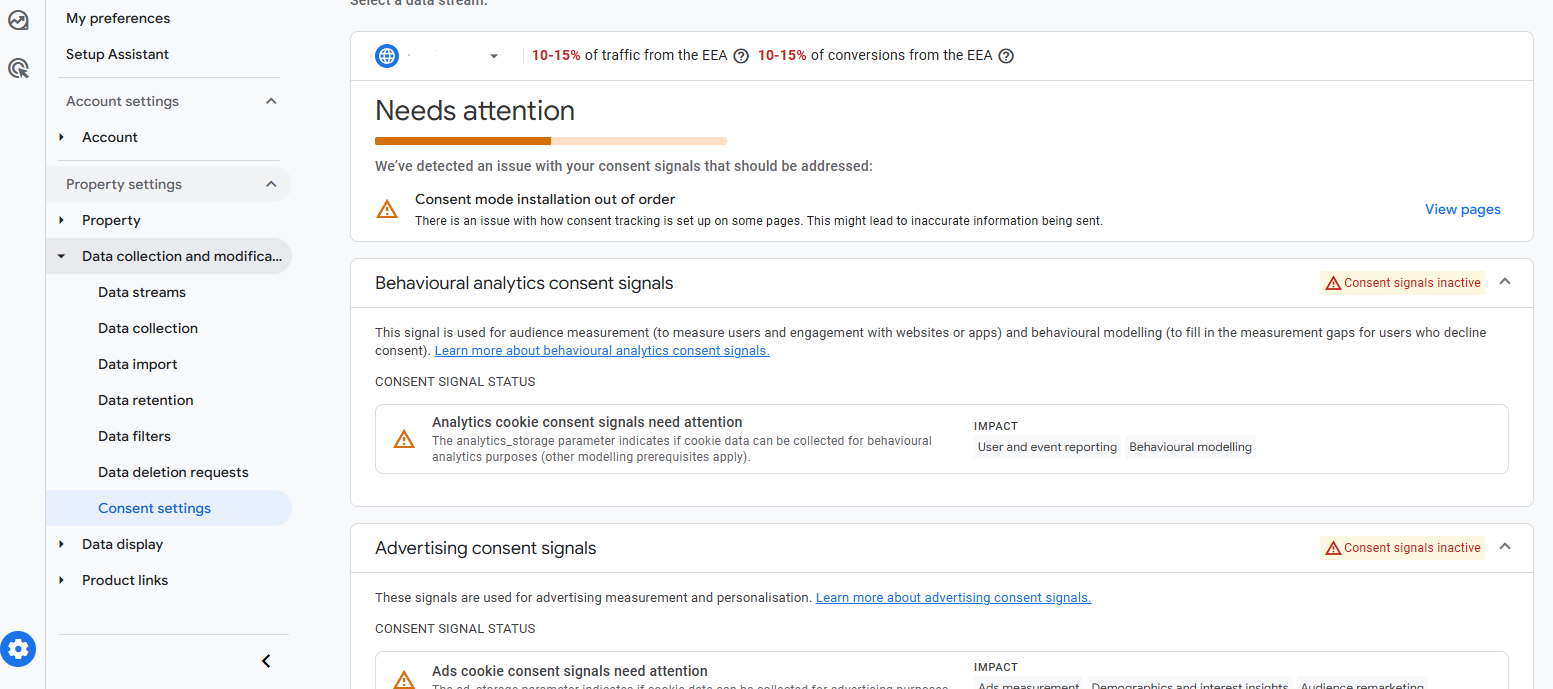GA Consent Mode v2 Is Now Non-Negotiable: What You Need to Know (and Fix Fast)

By Julian Erbsloeh|11 Aug 2025
If your Google Analytics data suddenly dried up for EEA and UK traffic tomorrow, would you know why?
From July 21, 2025*, Google began actively turning off advertising features for accounts that haven't implemented Consent Mode v2 for EEA/UK traffic. Remarketing, conversion tracking, and demographic reporting are now off the table.

Without the proper consent signals, data collection for these features is severely limited or (at least) non-existent for non-consenting EEA/UK traffic. However, some features may still function in a limited, non-personalised capacity or for users outside these two regions.
This move isn't just a compliance alert; if not dealt with, it will have a direct performance risk.
* The actual deadline for implementing Consent Mode v2 to maintain personalised advertising features for users in the European Economic Area (EEA) and the UK was March 6, 2024.
What's Happening?
Google is notifying advertisers that failure to implement Consent Mode v2 means:
- Remarketing lists won't populate
- Conversions from EEA users won't track
- Personalisation features are switched off
For Google Analytics to support these features, it now requires four consent parameters:
- analytics_storage
- ad_storage
- ad_user_data
- ad_personalization
No signal = no data = no audience targeting or conversion tracking.
What's at Stake?
1. Google Analytics and Google Ads Integration Breaks Down
Without Consent Mode v2, you'll lose access to:
- Remarketing audiences shared from Google Analytics to Google Ads
- Demographic data
- Conversion events for campaign optimisation
The change cuts off the very signals that help drive performance and ROI across campaigns.
2. Enforcement Is Active and Serious
Google is already issuing warnings. The next step? Functional shutdown. We've seen live examples where remarketing and conversion tracking were disabled across entire accounts. Unfortunately, this isn't a theory. It's real, and it's happening now.
3. Conversion Modelling Can Only Help If You've Implemented Properly
Consent Mode v2 enables Google's machine learning to model missing conversions where users decline tracking. Clients we work with have seen as much as a 70%+ recovery of 'lost' conversions through modelling. But here's the catch: if you have not set up Consent Mode v2, there's nothing to model.

Safeguard Your Google Analytics Data
"The shift to Consent Mode v2 isn't just about ticking a compliance box; it's about protecting the integrity of your data. We've seen first-hand how effective the modelling is, with a recovery of over 70% of lost conversions across our client base. It's the difference between a complete blackout of performance data and a clear, actionable view of your campaigns."
What To Do Now
Firstly, you need to understand the difference between the Basic and Advanced Consent Modes.
The Crucial Choice: Basic vs. Advanced Modelling
Before you take any technical steps, you must understand the two ways to implement Consent Mode v2. Your choice here fundamentally changes how much data you can recover and what you can do with it.
- Basic Consent Mode: This is the most restrictive option and completely blocks Google tags from firing until a user explicitly gives consent. If a user denies consent, absolutely no data is collected, not even anonymous signals. This mode leads to significant data loss and relies on a more general, less accurate form of modelling in Google Ads.
- Advanced Consent Mode: This is our recommended approach for marketers. Google tags fire with default "denied" settings, but they send cookieless pings to Google's servers even before the user makes a choice. These non-identifying pings contain anonymised data like device type and conversion type. This setting enables behavioural modelling in GA and a more accurate, advertiser-specific form of conversion modelling, which can recover a significant percentage of lost data.
For most businesses that rely on analytics and advertising to drive performance, Advanced Consent Mode is the non-negotiable standard. It allows you to maintain a comprehensive view of your website's performance while remaining fully compliant with privacy regulations.
What it Takes to Unlock Conversion Modelling
Conversion modelling enabled by Consent Mode v2 isn’t something that just switches on automatically. For Google’s machine learning to work effectively, it needs a certain level of user data to make accurate assumptions about those who opt out. Without enough of these signals, the system simply can’t model conversions or bridge the attribution gaps.
Your analytics property must meet the following thresholds for modelling to work:
- Sufficient Data Volume (Google Analytics): You must have at least 1,000 daily users with analytics_storage='granted' for a minimum of 7 of the previous 28 days. This data is the consented data Google uses to "train" its models on typical user behaviour.
- Sufficient Non-Consented Data (Google Analytics): You also need a minimum of 1,000 events per day with analytics_storage='denied' for at least 7 days. This info is the unobserved data that the model will be used to fill in.
- Google Ads Ad Clicks: To enable conversion modelling in Google Ads, a minimum threshold of 700 ad clicks per day is required, consistently over 7 days, for a given country and domain grouping.
- "Blended" Reporting Identity: Your GA property's Reporting Identity setting must be set to "Blended". This setting is the only reporting identity that incorporates modelled data into your reports, giving you a more complete picture of user activity.
Crucial Nuance: Meeting these thresholds makes your property eligible for modelling, but it does not guarantee it will start immediately. The process of training and activating the models can take additional time. It is also a continuous requirement; if your traffic or consent rates fall below these thresholds, modelling may be deactivated. It's important to remember that traffic consistency and a robust implementation are vital for long-term data accuracy.
Need help with missing GA data?
Now, Use the Following Checklist to Enable Consent Mode v2
1. Audit Your Consent Signals in GA
- Head to Admin > Data Collection and modification > Consent Settings.
- GA now flags missing signals directly in the UI.

2. Use a Google-Certified CMP or Verified GTM Template
- Either configure a Consent Management Platform (CMP) to send v2 signals or
- Implement Consent Mode manually via GTM or gtag.js.
- Don't cut corners; misconfigured signals won't be accepted.
3. Reconnect GA4 to Google Ads and Enable Ad Features
- Link your GA4 property to Google Ads.
- In GA4: ensure "Enable personalised advertising" is switched on.
- This ensures that audience data flows back into Ads correctly.
Why This Matters for Long-Term Strategy
This change isn't a one-off policy tweak, it's a signal of where digital is going.
Privacy-First Is the New Normal
Google's direction of travel is clear: fewer cookies, stricter compliance, more modelling. Performance teams that ignore this shift risk falling behind.
Intelligent Digital Experiences Need First-Party Signals
As standard, we design digital platforms to be consent-forward by default, meaning:
- Collecting high-quality, first-party data
- Using server-side tracking for greater control
- Leveraging tools like Customer Match and offline conversion imports, each of which requires Consent Mode to function

Check Your Google Analytics Data Integrity
Download your free template, then use our step-by-step guide in tandem to complete a GA health check.
Get Your Data Sorted
This change is not as easy as simply ticking a legal box. It's about protecting performance. If your GA4 property isn't passing Consent Mode v2 signals, you're already losing out on audiences, on attribution, and ultimately, on revenue.
Consent Mode v2 is now the fulcrum of measurement for EEA traffic. Conversion modelling helps, but only if Consent Mode is in place and functioning.
If you haven't audited your setup yet, do it today. We can help you:
- Run a full compliance and performance audit
- Configure Consent Mode accurately across CMPs, GTM, and gtag.js
- Protect the effectiveness of your measurement stack
- Translate complex updates into stakeholder clarity and confidence
Get Fresh Thinking and Stay Ahead of Digital Marketing Trends
Subscribe to our Fresh Thinking Newsletter and get...
✅ Exclusive invites to our helpful knowledge-share events✅ Curated news roundup of pertinent and topical industry news
✅ Early access to our industry resources and insights.
Register for Fresh Thinking and keep up to date with our helpful digital marketing news insights.